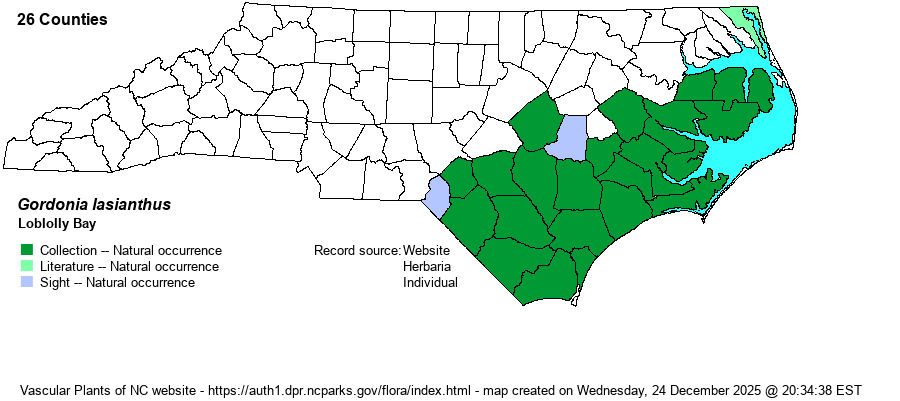| Author | (L.) Ellis | |
| Distribution | Ranges over most of the Coastal Plain, north to Currituck County, and inland to Johnston and Scotland counties. It is absent from the northwestern portions of the province, north of Johnston, Pitt, and nearly all counties north of Albemarle Sound. It does occur in Great Swamp in central Currituck County, its apparent northern outpost.
This is a Coastal Plain species ranging from eastern NC to southern FL, and west only to southern MS. It thus occurs in just six states, though within the range it is found in most Coastal Plain counties.
| |
| Abundance | A bit local in the Coastal Plain, but common to dominant in some areas, and uncommon in others. It is the main component of the Bay Forest natural community. Most numerous in areas with extensive pocosins and large peat-based Carolina bays. | |
| Habitat | This is one of the characteristic broadleaf trees of extensive pocosins and bays, along with the other two “bays” – Swamp Redbay (Persea palustris) and Sweetbay Magnolia (Magnolia virginiana). It is dominant in extensive peat-dome pocosins (such as in mainland Dare County), Croatan National Forest, Green Swamp, and Holly Shelter Swamp. It is also found in peat-filled Carolina bays, smaller bays and pocosins such as streamheads, and in other acidic wetlands such as some wet pine savannas. However, it is scarce to absent in the Sandhills region. |
| Phenology | Blooms from July to September, and fruits from September to October. Its late flowering period, for a tree species, makes it easy to identify at that season. | |
| Identification | This is a small to occasionally medium evergreen tree, with a distinctly narrow and spire-like crown (much like a cedar at a distance). It normally grows to about 40-50 feet tall, and it may occur in dense stands. Though evergreen, normally you can spot a few red leaves on the trees, at any season. The leaves are alternate, narrowly elliptical, thick and shiny, and about 4 inches long and only 1.5 inches wide. The margins have small teeth or “crenulations” and are thus not entire, whereas other bay species have entire leaves. The leaves and tree shape are usually enough for identification. However, in late summer the trees are festooned with its very large, white, five-petaled flowers, about 2.5-3 inches across. Though Sweetbay Magnolia has large white flowers, they are seen in spring or early summer and have numerous petals. At close range, these two are easily separated, though when speeding down a highway at 55 mph, and a pocosin/bay tree is covered with large white flowers, time of year and shape of the tree is a good clue. | |
| Taxonomic Comments | None. It is the only member of its genus in the U.S.
| |
| Other Common Name(s) | Gordonia, Loblolly-bay | |
| State Rank | S5 | |
| Global Rank | G5 | |
| State Status | | |
| US Status | | |
| USACE-agcp | FACW link |
| USACE-emp | FACW link |

